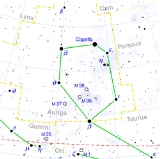
Zeta Aurigae
Encyclopedia
Zeta Aurigae is a star in the constellation
Auriga
. It has the traditional names Haedus (also Hoedus) and Sadatoni (rarely Saclateri). It is one of the two hædi (kids) of the she-goat Capella
, the other being Hoedus II, Eta Aurigae
. The name Sadatoni is from the Arabic الساعد الثاني as-sācid aθ-θānī "the second arm (of the charioteer)". The rare traditional name Azaleh is shared (in the form Hassaleh) with Iota Aurigae
.
In Chinese
, , meaning Pillars
, refers to an asterism consisting of ζ Aurigae, ε Aurigae
, η Aurigae
, υ Aurigae
, ν Aurigae, τ Aurigae, χ Aurigae
and 26 Aurigae
. Consequently, ζ Aurigae itself is known as
Zeta Aurigae is an eclipsing binary, which varies from magnitude
+3.61 to +3.99 with a period of 972 days.
The main star is a red supergiant, the companion belongs to the spectral class
B8. Zeta Aurigae is approximately 790 light-year
s from Earth.
Constellation
In modern astronomy, a constellation is an internationally defined area of the celestial sphere. These areas are grouped around asterisms, patterns formed by prominent stars within apparent proximity to one another on Earth's night sky....
Auriga
Auriga (constellation)
Auriga is a constellation in the northern sky. Its name is Latin for 'charioteer' and its stars form a shape that has been associated with the pointed helmet of a charioteer. It was one of the 48 constellations listed by the 2nd century astronomer Ptolemy, and remains among the 88 modern...
. It has the traditional names Haedus (also Hoedus) and Sadatoni (rarely Saclateri). It is one of the two hædi (kids) of the she-goat Capella
Capella (star)
Capella is the brightest star in the constellation Auriga, the sixth brightest star in the night sky and the third brightest star in the northern celestial hemisphere, after Arcturus and Vega. Although it appears to be a single star to the naked eye, it is actually a star system of four stars in...
, the other being Hoedus II, Eta Aurigae
Eta Aurigae
Eta Aurigae is a star in the constellation Auriga. Along with ζ Aurigae it represents one of the Kids of the she-goat Capella, from which it gets its Latin traditional name Hoedus II or Haedus II, from the Latin hædus "kid"; Zeta Aurigae is Hoedus I...
. The name Sadatoni is from the Arabic الساعد الثاني as-sācid aθ-θānī "the second arm (of the charioteer)". The rare traditional name Azaleh is shared (in the form Hassaleh) with Iota Aurigae
Iota Aurigae
Iota Aurigae is a star in the constellation Auriga. It has the traditional name Al Kab, short for Kabdhilinan, from the Arabic الكعب ذي العنان al-kacb ðīl-cinān "the ankle of the rein holder "...
.
In Chinese
Chinese language
The Chinese language is a language or language family consisting of varieties which are mutually intelligible to varying degrees. Originally the indigenous languages spoken by the Han Chinese in China, it forms one of the branches of Sino-Tibetan family of languages...
, , meaning Pillars
Net (Chinese constellation)
The Net mansion is one of the Twenty-eight mansions of the Chinese constellations. It is one of the western mansions of the White Tiger.-Asterisms:...
, refers to an asterism consisting of ζ Aurigae, ε Aurigae
Epsilon Aurigae
Epsilon Aurigae is a star in the constellation Auriga. It is traditionally known as Almaaz, Haldus, or Al Anz. Epsilon Aurigae is an unusual eclipsing binary system comprising an F0 supergiant and a companion which is generally accepted to be a huge dark disk orbiting an unknown object, possibly a...
, η Aurigae
Eta Aurigae
Eta Aurigae is a star in the constellation Auriga. Along with ζ Aurigae it represents one of the Kids of the she-goat Capella, from which it gets its Latin traditional name Hoedus II or Haedus II, from the Latin hædus "kid"; Zeta Aurigae is Hoedus I...
, υ Aurigae
Upsilon Aurigae
Upsilon Aurigae is a star in the constellation Auriga.Upsilon Aurigae is a M-type red giant with an apparent magnitude of +4.72. It is approximately 475 light-years from Earth.-References:* *...
, ν Aurigae, τ Aurigae, χ Aurigae
Chi Aurigae
Chi Aurigae is a binary star in the constellation Auriga. It is at least 2000 light-years from Earth.Chi Aurigae is a spectroscopic binary which is classified as a blue-white B-type supergiant with an apparent magnitude of +4.71. The binary has an orbital period of 655.16 days.-References:* *...
and 26 Aurigae
26 Aurigae
26 Aurigae is a star in the constellation Auriga. Its apparent magnitude is 5.40.-References:* * * -Components:...
. Consequently, ζ Aurigae itself is known as
Zeta Aurigae is an eclipsing binary, which varies from magnitude
Apparent magnitude
The apparent magnitude of a celestial body is a measure of its brightness as seen by an observer on Earth, adjusted to the value it would have in the absence of the atmosphere...
+3.61 to +3.99 with a period of 972 days.
The main star is a red supergiant, the companion belongs to the spectral class
Stellar classification
In astronomy, stellar classification is a classification of stars based on their spectral characteristics. The spectral class of a star is a designated class of a star describing the ionization of its chromosphere, what atomic excitations are most prominent in the light, giving an objective measure...
B8. Zeta Aurigae is approximately 790 light-year
Light-year
A light-year, also light year or lightyear is a unit of length, equal to just under 10 trillion kilometres...
s from Earth.

